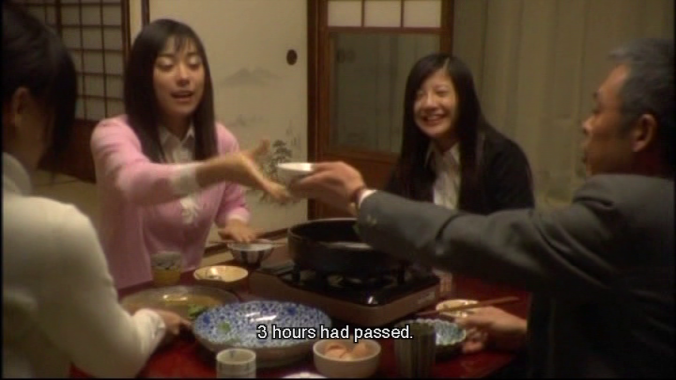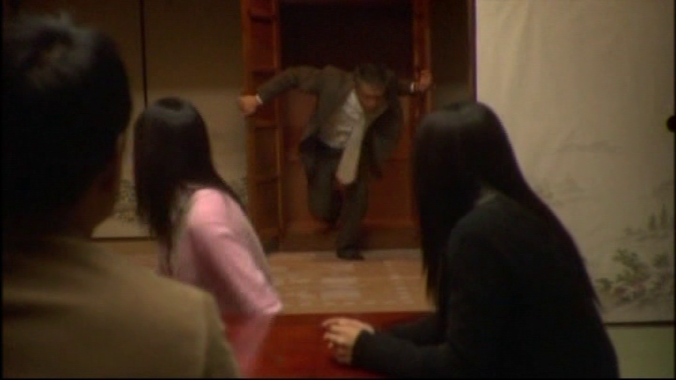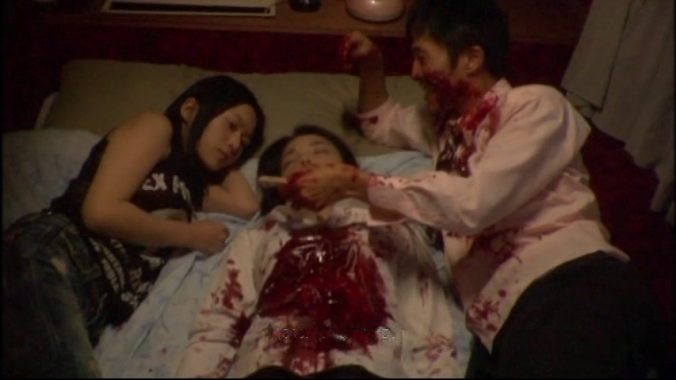 In simplest terms, Noriko is a teenaged girl from the provinces who runs away to Tokyo at Christmas and enters a world that she had never imagined possible. Instead of the story of a run-away drawn into the underbelly of prostitution and drugs that we might expect from such a beginning, Noriko’s Dinner Table is a haunting depiction of Japan’s cultural malaise of the early twentieth century. Despite interweaving with scenes from his earlier Suicide Club, Sion Sono makes something far more disturbing, with a depth and complexity that completely belies the reputation for shock and gore that he established with the earlier movie.
In simplest terms, Noriko is a teenaged girl from the provinces who runs away to Tokyo at Christmas and enters a world that she had never imagined possible. Instead of the story of a run-away drawn into the underbelly of prostitution and drugs that we might expect from such a beginning, Noriko’s Dinner Table is a haunting depiction of Japan’s cultural malaise of the early twentieth century. Despite interweaving with scenes from his earlier Suicide Club, Sion Sono makes something far more disturbing, with a depth and complexity that completely belies the reputation for shock and gore that he established with the earlier movie.
Told with almost uninterrupted narration, the movie flits around in time and place and style, following four main characters: Noriko, her younger sister Yuka, her father Tetsuzo, and the mysterious Kumiko. Noriko at 17 is a self-described “ditsy, stubborn, rebellious” girl. She demands more time on the school computers not to study but to log into her chatroom because her father is always using the home computer. There, she finds others like herself and is especially drawn to “Ueno Station #54,” the moderator who always seems to give good advice. When there is a power failure, she sneaks out in the dark and goes unannounced and unprepared to find #54. This turns out to be Kumiko, who meets Noriko at a coin locker in Ueno Station and introduces her happy family — Father, Mother, and Little Brother. They all rush off to visit Grandma, dragging Noriko along and introducing her as Mitsuko, her on-line pseudonym. Then there is a second Grandma, and it turns out that the family is not real but are people who for a fee play out visits for lonely people.
As the visits continue, Mitsuko turns out to be a natural actress and soon becomes a regular in the home visits, including an old man who wants to play his own death surrounded by crying family or a father whose daughters have run away who wants to be reunited (but not Noriko’s father).
Using the same chat group, Yuka too runs away, but her narration is more about her father. Before leaving, she writes a story about what her father and mother do after she disappears, and this is what we see on screen, rather than following Yuka to Tokyo, where she will only later appear as Yoko.
Kumiko claims to have been a baby abandoned in coin locker #54 at Ueno Station, and we follow her story for a while, but it is narrated by Mitsuko, who knows that all the stories about the memorabilia stored in the locker are false. But this leads us to other members of the chat group, three of which join the 54 girls who commit suicide in Shinjuku station from the earlier film. A fourth, called Broken Dam, explains to the group that some people are lions, some are rabbits, and she is happy to have learned that she is a rabbit. She then volunteers to play the unfaithful wife for a man in a hotel room, whom she knows will stab her to death before the hour session is over.
Finally, we return to Tetsuzo, who did not quit his job as a reporter on the local paper as Yuka had predicted in her story, which he finds and reads after his wife commits suicide. Only then does he track down the chat group and go to Tokyo, eventually recreating his old home in a Tokyo house and asking a friend to hire a family to “come home” after a vacation.  Then we are clearly in Pirandello territory, with a real father hiding in a wardrobe watching his real daughters pretend to be the daughters of his friend as they wait for dinner to be made by his pretend wife using his real wife’s name in a pretend home that looks just like the family’s old home.
Then we are clearly in Pirandello territory, with a real father hiding in a wardrobe watching his real daughters pretend to be the daughters of his friend as they wait for dinner to be made by his pretend wife using his real wife’s name in a pretend home that looks just like the family’s old home.
Though the Pirandellian theme of pretense and reality, of performance and real life, is ever present, the movie goes for far more than that, perhaps more than it can adequately deal with, even at its 160 minute length.
Sono repeats the questions asked in the earlier movie: “Are you connected to yourself?” “Are you connected to your family?” If there is an answer offered, it is most definitely no. As Noriko plays Mitsuko, she seems to completely lose her personality, sitting blankly in an empty room waiting for the next role to play. Everyone is searching for their real role and only finds fulfillment when the artificial role completely takes over to reveal the true inner self. Broken Dam knows she will be killed but is happy about it, even joking about the song the man has asked to be played while he kills her. Tetsuzo is staggered by how much he did not know about his family, failing to notice even the obvious despair of his wife after the two girls disappear.
There is much talk of the Circle of Life, sometimes even in the Lion King sense. Lions eat zebras, zebras eat grass, the grass regrows and the circle continues, as the representative for Kumiko’s company explains to Tetsuzo. The circle of life, death, and rebirth is essential to Buddhist thought, the circle repeating itself until at last your karma is completed. And in this particular case, there is a new, more physically present circle of life, the familiar circle going around on the computer screen as the internet connection is loading, and the circle of real/unreal friends to be found after it is loaded.
Many movies of this era have dealt with the destruction of the traditional family, but none in a more broad-ranging manner. All of Kumiko’s customers are people who have lost their family. Unlike the more famous later Tokyo Sonata, there is no economic trigger to the family’s collapse. Noriko and her family are happy and comfortable, father a reporter on a small town newspaper, not a salaryman, and his job is in no danger. Yet the family is a set of poses.
We saw the “professional substitute” as early as 1993, stepping in to tend graves or visit parents for busy children, and such companies have been reported in reputable sources to be in business in modern Tokyo, though one doubts if they ever go to such extremes. Now the parents are the customers themselves, especially the elderly, people who in modern Tokyo have lost contact with their children and grandchildren and want to pretend things are the way they are supposed to be, including staging their own deathbed scene.
But we also see a genuinely distraught man whose daughters, like Tetsuzo’s, have run away and whom he berates and even beats when the substitutes arrive. And, of course, there is the man whose wife has left him, who is willing to pay to have someone on whom he can vent his anger, actually killing her. Yet there is never a suggestion of prostitution in any of the girls’ encounters; the wife killer does not demand sex to celebrate her return before he kills her.
Also real are the coin locker babies, which became a national issue in the late seventies, about the time Ryu Murakami wrote his famous novel and when Kumiko would have been born. Women with an unwanted baby, or a baby they could not care for, would leave it in train station lockers, assuming their cries would be heard by station personnel, though many died. There may have been a famous case at about the time Sono was writing his script, since the station coin locker suddenly makes an appearance in several movies around this time where it signifies a chance at a new life.
Though the mass suicide plays a major role in the story, Kumiko does not appear to organize it. She does know of it, however, and even brings Noriko to witness as three of her girls join the group on the platform. How or why the girls assemble on the platform is still unexplained, though the internet is the ethereal force that somehow connects all the characters. The chat room is a way for people to connect with others in the safety of anonymity, which gives Noriko a sense of a different home and family. This is sometimes relatively positive, and sometimes ends in tragedy, but it is not the cause of new problems. Young people from the small town have always been lured by the lights of the big city, and in movies at least, it rarely turns out well, especially for girls. The Ko Gals did not need the internet, nor did the thousands of bar hostesses and prostitutes that made the sex trade flourish. It may seem ominous because it is new, but its novelty is what makes it seem menacing.
In spite of the complexity of the film, Sono still manages to live up to his reputation for shock and gore, with multiple replays of the subway suicides and a bloodbath when Tetsuzo is attacked by Kumiko’s guards. I can’t think of a more sickening scene in any movie than the one in which Broken Dam is murdered while Kumiko lies quietly smoking on the bed and then takes the fee from the killer. The camera work is mostly hand-held and often looks digital, and the movie jumps around in time and place, often in mid-sentence. Once we see Yuka writing her story, we can never be sure that what we are seeing is real, and the movie seems to have two endings, one terrifying and one dreamed up in Yuka/Yoko’s request for an extension of time for the session with their real father. Sono had begun publishing poetry in his teens and that cryptic, elliptical sense found in much of Japanese poetry informs the film as a whole, with narration and visuals often combining to make a third meaning. And it is long, though nothing near his 4-hour Love Exposure. Unlike Suicide Club, it doesn’t seem to get side-tracked, so that all the pieces actually fit together in a way that sustains interest throughout the length. If nothing else, it is a rare case of what began as a sequel turning out to be much more interesting than the initial film.
The camera work is mostly hand-held and often looks digital, and the movie jumps around in time and place, often in mid-sentence. Once we see Yuka writing her story, we can never be sure that what we are seeing is real, and the movie seems to have two endings, one terrifying and one dreamed up in Yuka/Yoko’s request for an extension of time for the session with their real father. Sono had begun publishing poetry in his teens and that cryptic, elliptical sense found in much of Japanese poetry informs the film as a whole, with narration and visuals often combining to make a third meaning. And it is long, though nothing near his 4-hour Love Exposure. Unlike Suicide Club, it doesn’t seem to get side-tracked, so that all the pieces actually fit together in a way that sustains interest throughout the length. If nothing else, it is a rare case of what began as a sequel turning out to be much more interesting than the initial film.

